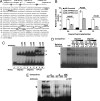A functional SNP of interferon-gamma gene is important for interferon-alpha-induced and spontaneous recovery from hepatitis C virus infection
- PMID: 17215375
- PMCID: PMC1783426
- DOI: 10.1073/pnas.0609954104
A functional SNP of interferon-gamma gene is important for interferon-alpha-induced and spontaneous recovery from hepatitis C virus infection
Erratum in
- Proc Natl Acad Sci U S A. 2007 Mar 13;104(11):4770
Abstract
Cytokine polymorphisms are associated with disease outcome and interferon (IFN) treatment response in hepatitis C virus (HCV) infection. We genotyped eight SNPs spanning the entire IFN-gamma gene in two cohorts and assessed the association between those polymorphisms and treatment response or spontaneous viral clearance. The first cohort was composed of 284 chronically HCV-infected patients who had received IFN-alpha-based therapy and the second was 251 i.v. drug users who had either spontaneously cleared HCV or become chronically infected. A SNP variant located in the proximal IFN-gamma promoter region next to the binding motif of heat shock transcription factor (HSF), -764G, was significantly associated with sustained virological response [P = 0.01, odds ratio (OR) = 2.66 [corrected] (confidence interval 1.3-5.6)[corrected]]. The association was independently significant in multiple logistic regression (P = 0.04) along with race, viral titer, and genotype. This variant was also significantly associated with spontaneous recovery [P = 0.04, OR = 3.51 (1.0-12.5)] in the second cohort. Functional analyses show that the G allele confers a two- to three-fold higher promoter activity and stronger binding affinity to HSF1 than the C allele. Our study suggests that the IFN-gamma promoter SNP -764G/C is functionally important in determining viral clearance and treatment response in HCV-infected patients and may be used as a genetic marker to predict sustained virological response in HCV-infected patients.
Conflict of interest statement
The authors declare no conflict of interest.
Figures

Similar articles
-
Association of TNF-alpha (-308 A/G) and IFN-gamma (+874 A/T) gene polymorphisms in response to spontaneous and treatment induced viral clearance in HCV infected multitransfused thalassemic patients.Cytokine. 2018 Jun;106:148-153. doi: 10.1016/j.cyto.2017.10.026. Epub 2017 Nov 28. Cytokine. 2018. PMID: 29196132
-
Confounding by Single Nucleotide Polymorphism rs117648444 (P70S) Affects the Association of Interferon Lambda Locus Variants with Response to Interferon-α-Ribavirin Therapy in Patients with Chronic Genotype 3 Hepatitis C Virus Infection.J Interferon Cytokine Res. 2017 Aug;37(8):369-382. doi: 10.1089/jir.2017.0002. Epub 2017 Jul 20. J Interferon Cytokine Res. 2017. PMID: 28727946
-
Interferon regulatory factor-1 promoter polymorphism and the outcome of hepatitis C virus infection.Eur J Gastroenterol Hepatol. 2006 Sep;18(9):991-7. doi: 10.1097/01.meg.0000224478.89545.76. Eur J Gastroenterol Hepatol. 2006. PMID: 16894313
-
Association of rs2111485 and rs1990760 Polymorphisms of Interferon Induced with Helicase C Domain 1 Gene with Hepatitis C Virus Clearance in Chinese Han Population.Viral Immunol. 2019 Oct;32(8):341-347. doi: 10.1089/vim.2019.0109. Epub 2019 Sep 20. Viral Immunol. 2019. PMID: 31539314
-
Understanding the molecular mechanism(s) of hepatitis C virus (HCV) induced interferon resistance.Infect Genet Evol. 2013 Oct;19:113-9. doi: 10.1016/j.meegid.2013.06.025. Epub 2013 Jul 5. Infect Genet Evol. 2013. PMID: 23831932 Review.
Cited by
-
Association of interferon gamma gene polymorphism and susceptibility to hepatitis C virus infection in Egyptian patients: A multicenter, family-based study.JGH Open. 2017 Dec 19;1(4):140-147. doi: 10.1002/jgh3.12024. eCollection 2017 Dec. JGH Open. 2017. PMID: 30483551 Free PMC article.
-
Induction and evasion of innate antiviral responses by hepatitis C virus.J Biol Chem. 2010 Jul 23;285(30):22741-7. doi: 10.1074/jbc.R109.099556. Epub 2010 May 10. J Biol Chem. 2010. PMID: 20457596 Free PMC article. Review.
-
Interferon gamma gene polymorphisms and chronic hepatitis B infections in an Iranian population.Turk J Gastroenterol. 2020 Jul;31(7):515-521. doi: 10.5152/tjg.2020.181024. Turk J Gastroenterol. 2020. PMID: 32897225 Free PMC article.
-
Effects of Bacille Calmette Guerin (BCG) vaccination during COVID-19 infection.Comput Biol Med. 2021 Nov;138:104891. doi: 10.1016/j.compbiomed.2021.104891. Epub 2021 Sep 29. Comput Biol Med. 2021. PMID: 34624759 Free PMC article.
-
Immunomodulatory factors gene polymorphisms in chronic periodontitis: an overview.BMC Oral Health. 2019 Feb 12;19(1):29. doi: 10.1186/s12903-019-0715-7. BMC Oral Health. 2019. PMID: 30755190 Free PMC article. Review.
References
-
- Liang TJ, Rehermann B, Seeff LB, Hoofnagle JH. Ann Intern Med. 2000;132:296–305. - PubMed
-
- Tan SL, He Y, Huang Y, Gale M., Jr Curr Opin Pharmacol. 2004;4:465–470. - PubMed
-
- Feld JJ, Hoofnagle JH. Nature. 2005;436:967–972. - PubMed
-
- Promrat K, Liang TJ. Hepatology. 2003;38:1359–1362. - PubMed
-
- Gao B, Hong F, Radaeva S. Hepatology. 2004;39:880–890. - PubMed
Publication types
MeSH terms
Substances
Grants and funding
LinkOut - more resources
Full Text Sources
Other Literature Sources
Medical

